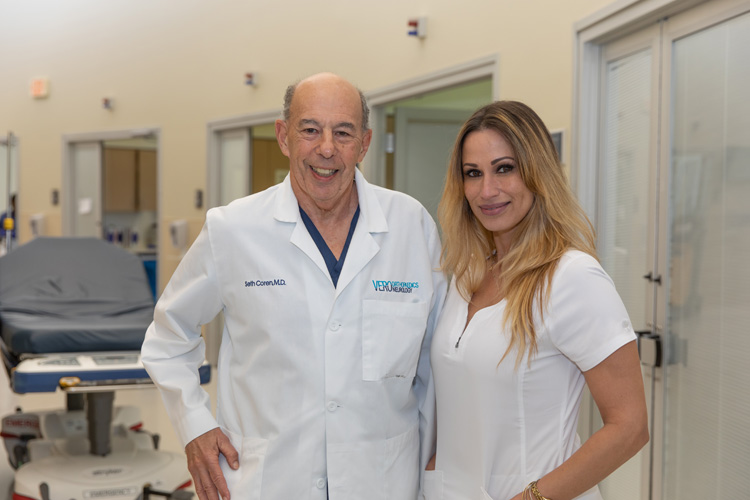
Most – if not all – of us hope to leave a legacy, something that will make the world a better place while we’re here and continue to do so after we’re gone.
Veteran Vero Beach orthopedic surgeon Dr. Seth Coren, with the help of registered nurse Maria Puras, may be on the cusp of creating just such a legacy in the form of a “fracture liaison service” devised by the doctor that is being put in place at Cleveland Clinic Indian River Hospital and could, someday, be instituted at other hospitals throughout the Cleveland Clinic system.
To understand Coren’s plan, you’ll need some numbers.
Over 10 million Americans have osteoporosis, a potentially lethal bone disease.
The National Osteoporosis Foundation says osteoporosis “occurs when the body loses too much bone, makes too little bone, or both. As a result, bones become weak and may break from a fall or, in serious cases, from sneezing or minor bumps.”
In addition to those 10 million with osteoporosis, another 44 million Americans suffer from low bone density, and while bone disease doesn’t get the headlines that heart disease and cancer do, the effects of brittle bones can be devastating.
For example, 86 percent of hip fractures, according the National Institutes of Health, “occur in individuals aged 65 and older” and the one-year death rate for those patients who have a hip fracture can be as high 58 percent.
That climbs to 62 percent the next year and 66 percent the year after that, and 4 percent more with each passing year.
Explains Coren: “What we’re in the process of starting and initiating is something called a fracture liaison service. The purpose of this is to identify people who are admitted to the hospital with specific fractures – primarily fractures of the hip, spine, pelvis, tibias and proximal humerus, which are called major orthopedic fractures” – in order to educate and treat them to prevent future fractures.
“The reason we’re doing this is that if you have a hip fracture or major osteoporotic fracture, then you have a significant risk for having more fractures,” Coren says, noting that older people and those with osteoporosis are most at risk.
Coren has been advocating for a fracture liaison service for a long time and, when pressed, he admits he has been a “squeaky wheel” in Vero Beach for years, lobbying the hospital to initiate such a program – with little to no success.
Until the Cleveland Clinic took over.
“In the past,” Coren says, “I hadn’t gotten any support from the hospital administration to expand this to the general population,” but Cleveland Clinic almost immediately stepped up.
“So, now we are in the process of creating assistance where, not only do patients get treated appropriately for their broken hip,” but also receive education and medications “so they don’t come back with another broken hip in the next year or two.”
“A lot of times the [fracture] patient gets lost. They’ll come in the hospital [to have their fracture fixed], they’ll go to rehab, and then they’ll get sent to their primary care physician, who may or may not treat the osteoporosis. The orthopedists [who set the bone or operate] aren’t looking to treat osteoporosis.
“One of the biggest advantages we have here is Maria,” Coren adds, turning to Puras. “She will follow that patient in rehab and then make sure the patient has had a bone density test, say within the first four to six weeks. If they haven’t, we’ll follow up from the fracture liaison service to make sure they do get properly treated.”
Puras jumps into the conversation, adding “so when a patient comes in and I see that one of the primary care physicians in the community is managing the patient, I call the doctor and I let them know the patient’s here with a fracture. If they want to manage it, I’ll still ask them to let me go ahead and do further studies.”
If the primary care doctor isn’t going to manage the post-fracture treatment, Puras continues, “then at that point we’re going to go ahead and refer out the consults to the people that do want to manage it. So preventative management is really what we’re looking at because it reduces the quality of life every time they fall and have to come into the hospital.
“And if they have another fracture, their quality of life every single time goes lower and lower and healthcare costs go higher and higher. We can prevent that from happening.”
There are currently a host of bone density medications including Forteo, Tymlos, Fosamax, Boniva and Prolia that help build bone and make future fractures less likely.
The best news, however, in Coren’s words, is that “we hope this may be something that we can export to the rest of the Cleveland Clinic.”
Systemwide. Nationwide. And maybe even someday, internationally.
And it’s coming at a bargain price, according to Coren. “The beneficial thing for Cleveland Clinic is it’s not costing them any money. I don’t get paid to do this.”
Of course, there are costs that Cleveland Clinic is picking up, including a new computer-tracking system that will launch soon, but those costs pale in comparison to Medicare re-admission fines triggered by patients that are treated, fall again and have to be readmitted, not to mention being able to offer osteoporosis patients a safer, healthier and happier future.
And that is the definition of a worthwhile legacy.




Comments: